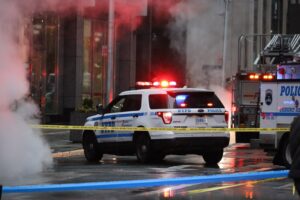More than three-quarters of the individuals who committed “mass attacks” exhibited concerning behaviors or shared alarming communications before carrying them out.
That’s the finding of a new U.S. Secret Service report released Wednesday. The agency’s National Threat Assessment Center (NTAC) analyzed 173 mass attacks between 2016 and 2020—incidents in which three or more people, not including the attacker, were harmed in public or semi-public places—to identify commonalities between the incidents that might be used to help prevent future attacks. The report found that nearly two-thirds of attackers during the study period had a history of making violent threats, and 64 percent had a history of criminal charges or arrests.
The report arrives on the heels of two separate mass killings in California that claimed the lives of 18 people in three days. The findings reveal that in most cases, attackers are on the radar of other community members or law enforcement. It suggests that more can be done to identify potential threats and stop future attacks.
“Everyone in the community plays a role in violence prevention,” Dr. Lina Alathari, NTAC’s Chief, said in a statement. “The latest NTAC report provides an unprecedented analysis to support our public safety partners and affirms that targeted violence is preventable if communities have the right information and resources to recognize warning signs and intervene.”
The report called on communities and workplaces to establish bystander reporting procedures and violence intervention programs to help identify at-risk individuals who exhibit concerning behaviors.
The attackers were overwhelmingly male and ranged in age from 14 to 87. The report noted that while nearly half of the attackers were white and one-third were black, there was no standard demographic profile for a mass attacker. Instead, the report says some commonalities can be gleaned from patterns of behavior engaged in by attackers leading up to an incident.
Over 40 percent of all attackers had a history of engaging in at least one domestic violence incident, and more than one-third had a history of harassing others and engaging in substance abuse. The report noted that while the vast majority of people suffering from mental health issues do not go on to commit violent acts, roughly 60 percent of the identified mass attackers experienced one or more mental health symptoms before or during their attacks.
NTAC said the warning signs can be noticeable and actionable, but there is no specific profile for who will become a mass killer.
“Many of the pre-attack behaviors described in this report are not suspicious on their own, and some involve constitutionally protected activity,” the report said. “Most individuals who exhibit these types of behaviors will not commit acts of targeted violence. NTAC’s research continues to affirm that there is no profile for the type of person who will commit an attack. The U.S. Secret Service recognizes behavioral threat assessment as the best practice for targeted violence prevention because it does not utilize profiles, but focuses on identifying and assessing threatening and concerning behavior in context, and identifying the most appropriate strategies for reducing any risk of violence, while also maintaining individual civil and constitutional rights.”
While the report did not focus on active shooters specifically, it did find that nearly three-quarters of mass attacks were committed with firearms during the five-year study period. Of the attacks committed with firearms, three-quarters were committed with handguns. In roughly one-quarter of the incidents, the gun used was obtained illegally, either through a straw purchase or theft.
Businesses represented the type of location targeted during most attacks, followed by public open spaces, including outdoor events and streets. Schools, residential communities, public transportation, religious gatherings, military institutions, and homeless shelters also saw incidents during the study period, though less frequently.







One Response
Thank you The Reload. I’m still in favor of “4 or more, minus the shooter(s), killed or wounded” for mass attacks, because the victims and their families and communities of that violence still suffer. I’m glad our US Secret Service did look at “attacks”, rather than just shootings.
How’s CNN? And how about follow ups from 97Percent.org? Do they, and any other sus orgs even listen to concepts like “defensive gun usage” and “natural rights”?